CBA announced its results for the financial year ended 30 June 2015. The Group’s statutory NPAT was $9,063 million, which represents a 5 per cent increase on the prior year. Cash NPAT was $9,137 million, also up 5 per cent. The Group also announced the launch of a $5 billion pro rata renounceable entitlement offer for all shareholders. The Group remained one of only a limited number of global banks in the ‘AA-’ ratings category.
Whilst an impressive result, we see signs of margin compression and rising levels of arrears, which, together with higher capital costs may constrain future momentum.
Group net interest income increased by 5 per cent, with average interest earning assets up $50 billion to $755 billion and retail and business average interest bearing deposits – up $32 billion to $445 billion. However, net interest margin (NIM) decreased by 5 basis points to 2.09 per cent year on year driven by the negative impacts of the falling cash rate environment and an increase in liquid assets. Excluding treasury and markets, Group NIM was down 1 basis point over the year in a highly competitive, low-rate environment. Underlying Group nim dropped 3 basis points in the second half. The Australian bank margin continues to slide, with pressure in the second half.
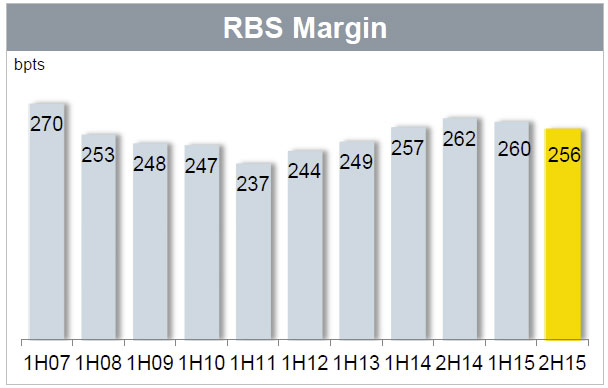 Other banking income increased 12 per cent due to increased commissions, higher trading income, which was driven by strong Markets sales and trading performance and a favourable counterparty valuation adjustment. This was partly offset by the implementation of a new derivative valuation methodology, Funding Valuation Adjustment (FVA), which resulted in an initial cost of $81 million.
Other banking income increased 12 per cent due to increased commissions, higher trading income, which was driven by strong Markets sales and trading performance and a favourable counterparty valuation adjustment. This was partly offset by the implementation of a new derivative valuation methodology, Funding Valuation Adjustment (FVA), which resulted in an initial cost of $81 million.
Funds management income was flat on a “headline” basis at $1,938 million. Excluding the impact of Property transactions and businesses from the comparative results, income increased 8 per cent, driven by a 14 per cent increase in average Funds Under Administration.
Insurance income decreased 3 per cent due to an unusually large number of weather event claims during the year in New South Wales and Queensland.
Expense growth was higher, increasing 5 per cent on the prior year, due to staff expenses and the impact of the lower Australian dollar. The major driver of expense growth was growing regulatory, compliance and remediation costs, including those associated with a number of legislative reforms (FATCA, FoFA, Stronger Super), provisioning for the costs of the Advice Review program and ongoing regulatory engagement.
The Group improved its cost-to-income ratio by 10 basis points to 42.8 per cent, assisted by the continued focus on productivity initiatives which delivered savings of $260 million over the past 12 months.
In a relatively stable credit environment, the ratio of cash loan impairment expense (LIE) to gross loans and acceptances remained unchanged at 16 basis points. Total loan impairment provisions were $3.6 billion, and the ratio of provisions to credit risk weighted assets at 1.14 per cent.
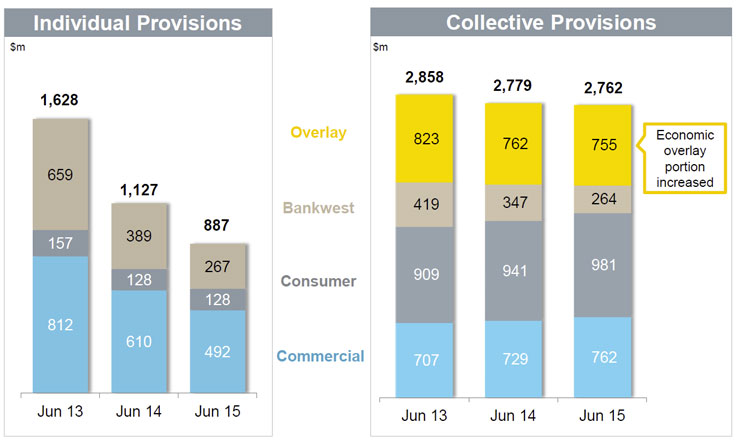 Collective provisions included a management overlay of $755 million including an increased economic overlay. 90 day home loan arrears are higher at Bankwest.
Collective provisions included a management overlay of $755 million including an increased economic overlay. 90 day home loan arrears are higher at Bankwest.
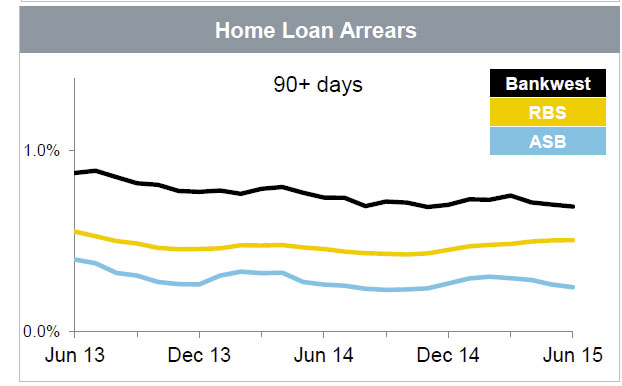 Customer deposits, now account for 63 per cent of total funding. During the year, the Group issued $31 billion of long-term wholesale debt in multiple currencies.
Customer deposits, now account for 63 per cent of total funding. During the year, the Group issued $31 billion of long-term wholesale debt in multiple currencies.
The Group continued to invest in the long-term growth of the business, with $1.2 billion invested on initiatives including risk and compliance projects, technology and productivity; Ongoing organic capital generation delivered a Basel III CET1 ratio of 12.7 per cent on an internationally comparable basis and 9.1 per cent on an APRA basis. The APRA change increases risk weights from approximately 16% to 25%. As at 30 June 2015, the impact for CBA would result in a decrease of 95bps in CET1 (approximately $4bn).
The Group will offer entitlements to CBA ordinary shares pro rata to all eligible shareholders, which can be exercised to buy 1 new share for every 23 shares held on the record date for the offer at an offer price of $71.50 per new share at a 10.5 per cent discount to the dividend adjusted closing price on the ASX on 11 August 2015. The offer will be fully underwritten to raise approximately $5 billion. Approximately 71 million new fully paid CBA ordinary shares will be issued (approximately 4.3 per cent of shares on issue). Following the capital raising, the Group’s pro forma CET1 ratio will be 14.3 per cent on an internationally comparable basis (which assumes full implementation of the Basel III reforms), and 10.4 per cent on an APRA basis. In December 2013, APRA announced that the Australian major banks are domestic systemically-important banks (D-SIBs). From 1 January 2016, D-SIBs are required to hold 1% additional capital in the form of CET1 (called the D-SIB buffer)
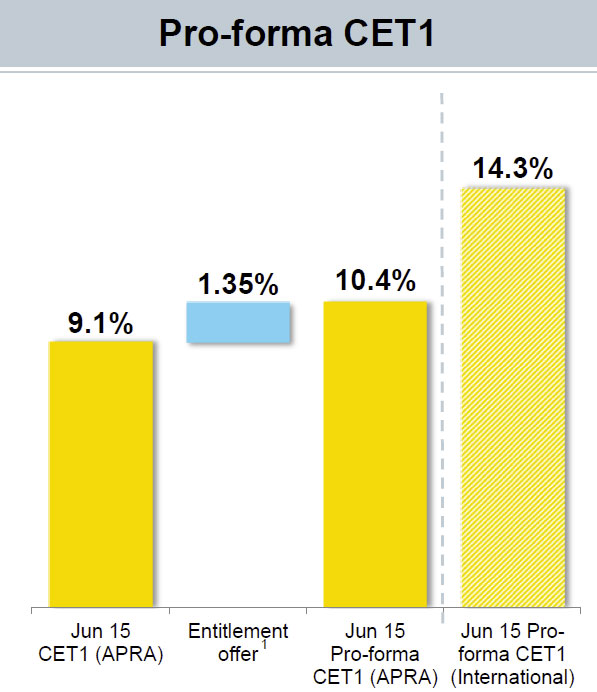 Interesting to note the flow through of online activity into the bank, with the proportion of logins via a mobile device, and online sales rising. Absolutely no surprise, as foreshadowed in the DFA “Quiet Revolution” report. 39% of credit card sales were online.
Interesting to note the flow through of online activity into the bank, with the proportion of logins via a mobile device, and online sales rising. Absolutely no surprise, as foreshadowed in the DFA “Quiet Revolution” report. 39% of credit card sales were online.
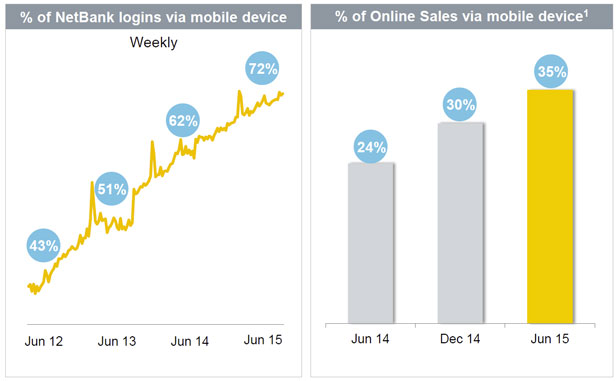 Finally, looking at the Australian Home Loan portfolio, CBA has the largest footprint for owner occupied loans. The chart below shows the combined CBA and Bankwest portfolio. Arrears are lowest in the fastest growing state, NSW.
Finally, looking at the Australian Home Loan portfolio, CBA has the largest footprint for owner occupied loans. The chart below shows the combined CBA and Bankwest portfolio. Arrears are lowest in the fastest growing state, NSW.
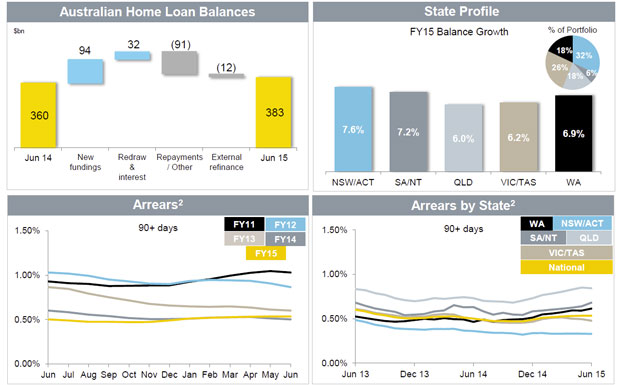 Looking specifically at investment property loans, CBA is growing its portfolio below the 10% speed limit, (9.7% compared with 11.5% system), and show lower arrears in the investment portfolio, and a larger borrower income footprint.
Looking specifically at investment property loans, CBA is growing its portfolio below the 10% speed limit, (9.7% compared with 11.5% system), and show lower arrears in the investment portfolio, and a larger borrower income footprint.
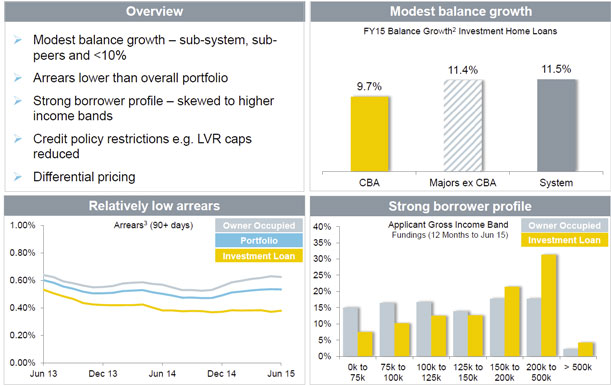 They provided one stress test scenario, in which stressed losses could be $3.17bn over 3 years, of which $1.98bn would be losses net of LMI recoveries. This is based on December 2014 data. Total stressed losses increased by 1% between June 2014 ($3.14bn) and December 2014 ($3.17bn), primarily due to growth in the Home Loan portfolio.
They provided one stress test scenario, in which stressed losses could be $3.17bn over 3 years, of which $1.98bn would be losses net of LMI recoveries. This is based on December 2014 data. Total stressed losses increased by 1% between June 2014 ($3.14bn) and December 2014 ($3.17bn), primarily due to growth in the Home Loan portfolio.
